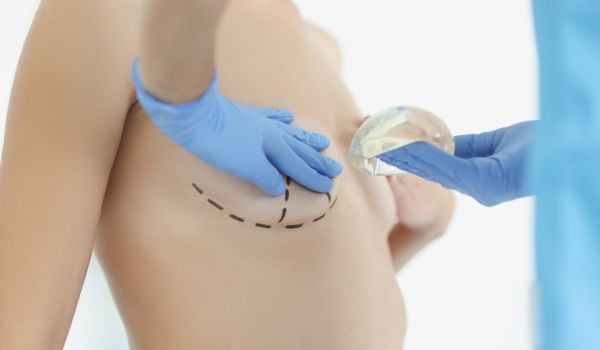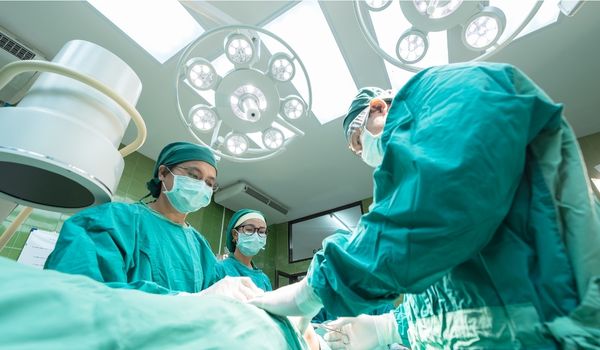
Uniboob/ No Separation between the Breasts after Breast Implant Surgery
Symmastia or synmastia is a condition in which the two breasts appear joined in the middle of the chest. It’s a rare complication that can occur after breast augmentation surgery or breast reconstruction with implants.
Symmastia is usually the result of poor surgical techniques or oversized implants. However, patients with thin chest muscle, under-the-muscle implants, or a history of breast surgery have a higher risk of symmastia after breast implant surgery.
Corrective breast surgery can successfully repair a symmastia implant complication.
In this article, we’ll discuss what is Symmastia, what causes it, how is it treated and what can be done to prevent it.
What Is Symmastia (Synmastia)?
Symmastia occurs when the two breasts appear too close together with little or no cleavage. It’s a rare complication that can happen following breast augmentation with implants or reconstruction surgery.
Derived from Greek, both prefixes “syn” and “sym” mean together, and “mastos” means breast. That’s why you may find this condition spelled symmastia in some references and synmastia in others.
There are two types of symmastia; congenital and acquired. People with congenital symmastia are born with this very rare condition. On the other hand, acquired or iatrogenic symmastia develops as a complication after breast implant surgery.
Synmastia after breast augmentation surgery is commonly known as uniboob or breadloafing.
Although it’s rare, acquired synmastia makes the breasts appear conjoint with little to no separation between the implants after surgery. Instead, the two breasts are connected by a layer of skin, fat, and other tissue across the cleavage area.
What Causes Symmastia after Breast Augmentation Surgery?
Doctors still don’t know what exactly causes congenital synmastia. However, acquired symmastia usually results from either poor implant selection or excessive tissue dissection during breast implant surgery.
The breasts have cleavage because the skin in the area between them is attached to the midline of the chest wall (sternum), creating a separation between the breasts. Muscle fibres in the chest help the skin stay connected to the sternum and keep the breasts separated.
During breast augmentation or reconstruction surgery, anything that disrupts the area where the skin adheres to the chest can result in breast symmastia.
1. Excessive tissue dissection
During a breast reconstruction or augmentation surgery, the surgeon creates a pocket for each breast implant above or below the chest muscle. The breast pocket should be the same size as the implant or slightly larger.
During submuscular (below the muscle) breast implant surgery, the surgeon will dissect the Pectoralis major muscle on each side of the chest, pull it away, and create a pocket for the implant underneath it.
If the surgeon accidentally cuts through the Pectoralis muscle, the muscle may rupture. A ruptured Pectoralis major muscle can pressure the breast implant underneath it and push it closer to the middle of the chest. That decreases the space between the two implants.
Moreover, the surgeon may accidentally cut through the muscle fibres connecting the skin in the middle of the chest to the sternum.
Consequently, the breast implants are pushed closer together with the skin between them at the midline released. That leads to symmastia or a uniboob appearance after breast implant surgery.
The same can happen when creating pockets for subglandular (over the muscle) implants. The chest pocket can become too large for the implant if the surgeon dissects the breast tissue too much. As a result, the implants can shift from their place and move closer to the middle of the chest.
2. Capsular contracture
Capsular contracture happens when a band of thick scar tissue tightens and contracts around the breast implant after breast augmentation surgery.
A capsule of scar tissue can push the implant out of its place and eventually bring the two implants closer together, resulting in symmastia.
3. Oversized implants
Symmastia can also be the result of oversized implants. Sometimes both surgeons and patients choose implants that are too big or too wide for the patient’s chest.
When the implants are too big, they may not fit the pockets made for them in the chest. Consequently, large implants may push through their pockets with time. Eventually, the two pockets may join, creating one large space for both implants and resulting in synmastia.
4. Misplacement of implants
Sometimes, the surgeon may incorrectly position the implants too close together. That can lead to symmastia after breast reconstruction or augmentation surgery.
What Are the Risk Factors of Symmastia After Breast Implant Surgery?
Symmastia happens after breast augmentation or reconstruction surgery mainly because of a surgical mistake or poor preoperative planning. Nonetheless, some risk factors can increase the chances of synmastia after breast implant surgery, such as:
- Thin Pectoralis major muscle: patients with a thin Pectoralis major muscle have a higher risk of chest muscle tears following breast surgery. Therefore, patients with thin pectoral chest muscles are more likely to develop symmastia following breast implant surgery
- Subpectoral implant placement: to position the implant under the Pectoralis muscle, the surgeon has to dissect and pull the chest muscle away. That increases the risk of excessive dissection and, consequently, the risk of symmastia
- Multiple breast surgeries: patients with a history of breast augmentation or reconstructive surgery have a higher risk of developing post-surgical complications, including synmastia
How Is Symmastia Treated?
Breast revision surgery is the only way to correct symmastia after getting breast implants.
The steps during breast correction surgery for symmastia will depend on the position of the implants and whether there is capsular contracture.
During symmastia repair surgery, the surgeon will:
- Remove the breast scar tissue that is causing capsular contracture
- Repair the Pectoralis major muscle
- Reconstruct the breast pockets of the implants
- Reposition the implants
- Replace the implants with smaller ones if they’re too big or too wide for the chest
- Excess fat may also be removed from the sternum area to create more space between the breasts
- Reattach the released muscle fibres and skin to the sternum
- Use permanent internal sutures to hold both the breasts and implants firmly in place
If you’re bothered by the appearance of your breasts after getting implants, it’s worth considering corrective breast surgery.
Nonetheless, keep in mind that breast symmastia corrective surgery can result in complications, such as asymmetrical breasts, an irregular breast contour, and additional breast scarring.
Can You Prevent Symmastia?
The best way to avoid symmastia is by choosing a highly skilled and experienced plastic surgeon to perform your breast implant surgery.
Your surgeon can minimise the risk of postoperative synmastia by performing careful, delicate surgical techniques and choosing the right type of breast implant for your body.
Is Symmastia a Dangerous Complication?
Symmastia doesn’t usually cause any health concerns.
However, this complication can make the breasts appear deformed and negatively affect the patient’s quality of life.
Consult your plastic surgeon if your breasts appear too close after getting breast implants. The sooner symmastia is treated, the better. If the implants continue to shift, synmastia might become harder to repair.
After a thorough examination, your surgeon can also determine whether you have additional problems that need to be addressed, such as capsular contracture.
Corrective surgery can successfully treat symmastia. Before deciding on revision surgery for symmastia, you can consult with more than one plastic surgeon with experience in this type of reconstructive surgery.
Medical References about Symmastia and Breast Augmentation Surgery
- Iatrogenic Symmastia: Causes and Suggested Repair Technique
- Synmastia: prevention and correction
- Recovery after Breast Augmentation Surgery by Dr Michael Kernohan
- Breast Revision Surgery Melbourne by Dr Carmen Munteanu
- Plastic Surgery Risks and Complications – Dr. Guy Watts
- How to Improve your Recovery After Breast Augmentation




